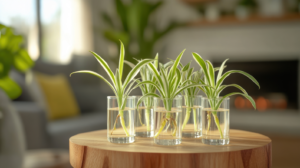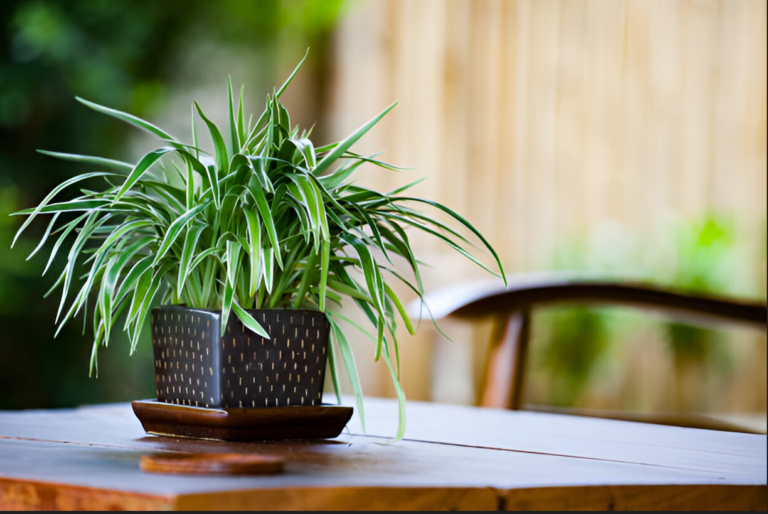The spider plant (Chlorophytum comosum) is one of the most popular indoor plants worldwide, known for its unique appearance and air-purifying qualities. With arching leaves and small “babies” (or spiderettes), it’s not only a beautiful addition to any room but also a powerful ally in creating a healthier indoor environment. Whether you’re a beginner or an experienced plant parent, this guide will take you through everything you need to know about the spider plant, from its health benefits to its care requirements and propagation tips.
What Makes the Spider Plant Special?
Originating from southern Africa, the spider plant is celebrated for its low-maintenance nature and adaptability. Known for its ability to thrive in various indoor conditions, it’s a perfect choice for those looking to add greenery without extensive upkeep.
Health Benefits and Air Purifying Qualities
Did you know that the spider plant was featured in NASA’s Clean Air Study as one of the best air-purifying plants? This study highlighted its effectiveness in filtering out toxins like formaldehyde and xylene from the air, which can be found in household products like cleaners and furniture finishes. For other air-purifying plants you can add to your home, you might enjoy learning about the benefits of the snake plant, another hardy option that complements the spider plant in creating a healthy indoor atmosphere.
Moreover, the spider plant contributes to a healthier environment by adding moisture to the air, which can help reduce dust particles. Its ability to absorb allergens makes it a popular choice for homes, especially where there are children or pets.
Essential Characteristics of the Spider Plant
Appearance and Types
The spider plant has long, arching leaves that create a cascading effect, often with a green and white variegated pattern. Some popular varieties include:
- Chlorophytum comosum ‘Vittatum’: Characterized by green leaves with a white central stripe.
- Chlorophytum comosum ‘Variegatum’: Known for green leaves with white edges.
These varieties make it versatile for home decor, allowing you to add visual interest to any space.
How to Care for Your Spider Plant
One of the main reasons for the popularity of spider plants is their minimal care requirements. However, to help them thrive, it’s essential to understand their specific needs.
Light Requirements
Spider plants prefer indirect light but can adapt to lower light conditions. Direct sunlight may cause the leaves to scorch, so placing them near a window with filtered light is ideal. For other low-light indoor plants that pair well with spider plants, consider reading this guide on cactus care for more inspiration.
Watering Needs
The spider plant enjoys moderate watering. Water it once the top inch of soil feels dry, and avoid overwatering to prevent root rot. Using a well-draining potting mix is also beneficial.
Temperature and Humidity
These plants thrive in typical indoor temperatures (60–80°F) and benefit from moderate humidity. They can handle dry indoor air, but occasional misting will keep them happy and reduce the risk of brown leaf tips.
Propagating Spider Plants

One of the most exciting aspects of the spider plant is its ability to propagate easily, thanks to the spiderettes that dangle from mature plants. Here’s how you can propagate your spider plant:
- Identify Healthy Spiderettes: Look for spiderettes that have small roots forming at the base.
- Cut and Plant in Soil: You can cut the spiderettes and place them directly into the soil.
- Water and Wait: Keep the soil moist until the new plant establishes roots, and you’ll have a new spider plant in no time.
For those who prefer water propagation, you can place the spiderettes in water until they grow roots before transferring them to soil.
Troubleshooting Common Spider Plant Problems
Even though spider plants are resilient, they can occasionally run into issues. Here are some common problems and solutions:
- Brown Tips on Leaves: This is often caused by dry air, fluoride in water, or over-fertilizing. Misting the plant and using filtered water can help.
- Yellowing Leaves: Overwatering or poor drainage can lead to yellow leaves. Ensure the pot has drainage holes and let the soil dry slightly between waterings.
- Pests: Spider plants can attract pests like aphids and spider mites. Regularly inspect your plant and use insecticidal soap if needed.
For a broader understanding of pest control, check out this comprehensive guide to aphid management which may come in handy.
Decorating with Spider Plants in Your Home
Spider plants are extremely versatile when it comes to home decor. Here are some ideas for incorporating them into your space:
- Hanging Baskets: Their cascading nature makes them perfect for hanging baskets.
- Tabletop Accents: Use smaller plants to decorate tabletops or shelves.
- Vertical Gardens: Arrange multiple spider plants to create a lush, green wall effect.
By adding spider plants to various rooms, you’ll not only improve air quality but also enhance the aesthetic appeal of your home.
Environmental Impact and Sustainability
The spider plant is an eco-friendly choice for homes. Its low-maintenance needs mean less water and energy are required to keep it healthy. Additionally, by naturally purifying the air, it reduces the need for air purifiers, contributing to a greener lifestyle. For more on the environmental impact of indoor plants, check out the American Society for Horticultural Science’s research.
FAQs About Spider Plants
Here are some commonly asked questions about spider plants:
- How often should I water my spider plant?
Water when the top inch of soil is dry to the touch, usually once a week. - Why are the leaves of my spider plant turning brown?
Brown tips may indicate dry air, poor water quality, or over-fertilizing. Try using filtered water and misting the plant. - Can spider plants survive in low light?
Yes, while they prefer bright, indirect light, spider plants can adapt to low light settings. - Are spider plants safe for pets?
According to the ASPCA, spider plants are non-toxic to cats and dogs, though they may cause mild digestive upset if ingested in large quantities. - How do I encourage my spider plant to grow spiderettes?
Ensure it’s getting adequate light and that you’re not overwatering, as both factors encourage the production of spiderettes.
Conclusion
The spider plant is more than just a decorative piece; it’s a low-maintenance, air-purifying plant that benefits both the home and the environment. Whether you’re interested in improving air quality, reducing allergens, or simply adding greenery to your space, the spider plant is an excellent choice. With its easy propagation and versatile decor options, it’s no wonder this plant has remained a household favorite for generations.
With these care tips and insights, you’re well-equipped to enjoy all the benefits that spider plants have to offer. 🌿 Enjoy creating a healthier, greener home with this beautiful plant!
